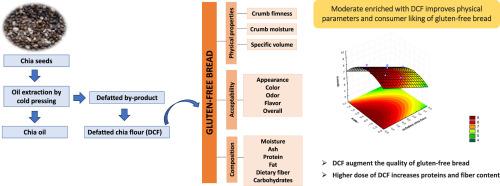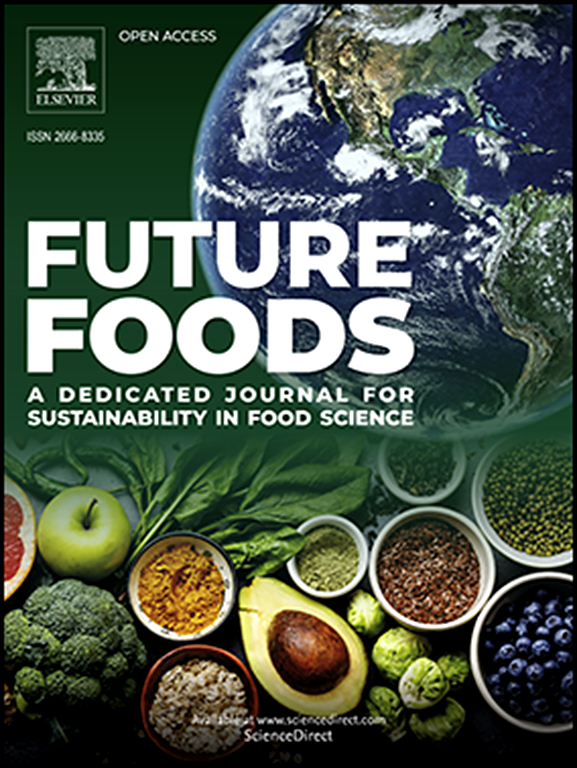Partially defatted chia flour as a novel ingredient for gluten-free breadmaking: Improving sustainability, nutrition and consumer liking
IF 7.2
Q1 FOOD SCIENCE & TECHNOLOGY
引用次数: 0
Abstract
Partially defatted chia flour (DCF) is a valuable food ingredient in the context of a circular economy, with the potential to improve the nutrient and bioactive contents of gluten-free foodstuff. Thus, this study assessed the effects of interactions between DCF and water content (W) on the physical and sensory properties of gluten-free bread (GFB) and defined, using the response surface method, the composition of formulations that enable quality optimization. A rotatable central composite design was used to assess the main and interaction effects of DCF (ranging from 0 to 28% on a flour basis (fb) and W (ranging from 100 to 200% fb) on the physical properties and consumer linking of rice flour based GFB. The resulting models indicated that higher DCF or W levels diminished the bread quality. However, different W and up to 17.2% DCF can be used to prepare bread with high consumer liking (scores ≥7 for all assessed characteristics, on a scale of 10). The formulation prepared with 0% DCF and 135.5% W (fb) had the highest degree of liking (varying from 8.3 to 9.0). However, when incorporating up to 9.8% DCF and 135.5% W, a high liking can be maintained (scores 8.0 to 8.5 for all characteristics). Acceptable GFB with up to 17.2% DCF in the formulation can be obtained if the W content is adjusted (135 to 139.7% fb). Incorporating 17.2% DCF doubles the fiber content of the GFB. Therefore, DCF is an alternative ingredient to obtain nutritionally improved and acceptable GFB.

部分脱脂奇异果粉作为无麸质面包的新型配料:改善可持续性、营养和消费者喜好
部分脱脂奇异果粉(DCF)是循环经济背景下一种有价值的食品配料,具有提高无麸质食品的营养和生物活性含量的潜力。因此,本研究评估了 DCF 和水含量(W)之间的相互作用对无麸质面包(GFB)物理和感官特性的影响,并采用响应面法确定了可实现质量优化的配方组成。采用可旋转的中心复合设计来评估 DCF(以面粉为基准,从 0% 到 28% 不等)和 W(以面粉为基准,从 100% 到 200% 不等)对以米粉为基础的无麸质面包的物理特性和消费者联系的主要效应和交互效应。结果表明,较高的 DCF 或 W 水平会降低面包质量。然而,使用不同的 W 和高达 17.2% 的 DCF 可以制备出消费者非常喜欢的面包(在 10 分制中,所有评估特征的得分均≥7 分)。用 0% DCF 和 135.5% W 配制的配方(fb)消费者的喜爱程度最高(从 8.3 到 9.0 不等)。然而,当添加高达 9.8% 的 DCF 和 135.5% W 时,仍能保持较高的喜好度(所有特征的评分都在 8.0 到 8.5 之间)。如果调整 W 含量(135% 至 139.7%fb),配方中 DCF 含量高达 17.2%时,可获得可接受的 GFB。加入 17.2% 的 DCF 可使 GFB 的纤维含量增加一倍。因此,DCF 是一种替代配料,可用于获得营养上得到改善且可接受的 GFB。
本文章由计算机程序翻译,如有差异,请以英文原文为准。
求助全文
约1分钟内获得全文
求助全文
来源期刊

Future Foods
Agricultural and Biological Sciences-Food Science
CiteScore
8.60
自引率
0.00%
发文量
97
审稿时长
15 weeks
期刊介绍:
Future Foods is a specialized journal that is dedicated to tackling the challenges posed by climate change and the need for sustainability in the realm of food production. The journal recognizes the imperative to transform current food manufacturing and consumption practices to meet the dietary needs of a burgeoning global population while simultaneously curbing environmental degradation.
The mission of Future Foods is to disseminate research that aligns with the goal of fostering the development of innovative technologies and alternative food sources to establish more sustainable food systems. The journal is committed to publishing high-quality, peer-reviewed articles that contribute to the advancement of sustainable food practices.
Abstracting and indexing:
Scopus
Directory of Open Access Journals (DOAJ)
Emerging Sources Citation Index (ESCI)
SCImago Journal Rank (SJR)
SNIP
 求助内容:
求助内容: 应助结果提醒方式:
应助结果提醒方式:


